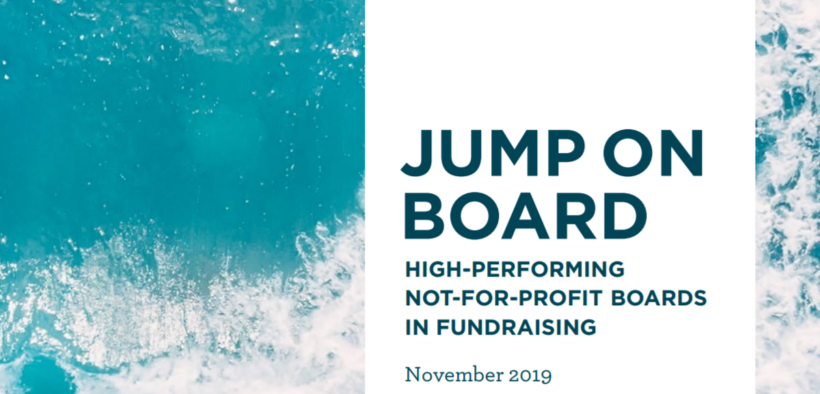Driving a culture of philanthropy and 100 per cent Board participation in giving will be critical in attracting greater philanthropic investment in the future, however confidence and culture are holding Boards back, a new report released by Perpetual and Noble Ambition has found.
Perpetual has partnered with strategic fundraising expert and Director & Founder of Noble Ambition, Melissa Smith, on a white paper which aims to help Boards and CEOs improve their fundraising. The white paper “Jump on Board: High-performing not-for-profit boards” in fundraising, explores the role not-for- profit (NFP) Board Directors and Chairs play in fundraising, and how Boards can attract greater philanthropic investment in the future.
Caitriona Fay, General Manager of Community & Social Investment at Perpetual, said the report found Australian NFP Boards do not currently demonstrate the fundraising leadership required to drive meaningful cultural change within the broader context of their governance responsibilities.
“Many boards seem to think fundraising sits over there with someone else. Too many see it purely as a management issue, rather than a key governance issue that needs to be addressed both from a strategy and oversight perspective,” she said.
According to Fay, fundraising needs to evolve to a whole-of-Board capability and should be a supporting pillar to a Board’s role of governance, strategy and advocacy. Boards need to understand enough to ask questions about whether the fundraising approach is tracking in the right direction and whether the lead indicators for fundraising for success are all there.
Smith also commented, “The role of the Board is critical in not only being able to advocate for the organisation, but also personally to give and to personally ask others to give.”
Confidence and culture remain significant barriers for NFP Boards. The research revealed confidence and culture were two substantial barriers to achieving greater participation in fundraising at Board level for Australian NFPs.
To create a culture of giving, Chairs must lead by example and share clear and consistent messaging about Board engagement in fundraising.
“100 per cent Board participation in fundraising is about more than just dollars raised and a monetary donation, it is about the broader value Directors can bring to NFP fundraising,” added Smith.
“Confidence was also found to be a significant challenge for Australian NFP Boards. To thrive in an increasingly sophisticated fundraising environment organisations must invest in fundraising strategy and capacity building at a leadership level,” she said.
There are four pillars to Australian Board engagement in NFP fundraising. When examining an Australian approach to NFP Board involvement in fundraising, David Gonski AC, President, Art Gallery of New South Wales (AGNSW) and Chancellor, The University of New South Wales (UNSW), advocates a diverse Board that reflects the interests of the community an organisation serves.
Gonski commented, “I certainly believe that people who are well-connected, and/or wealthy, who take on these not-for-profit Boards must be prepared to Give, Get, or Get Off. But I also believe that not-for-profits and their Boards should not only be the provenance of the rich. And therefore, I can see that you could have two lots of people, both contributing in their own way.”
The white paper identified four pillars to allow Directors to contribute to the fundraising goals of their organisation in varied ways. Pillar one: Give sees that if Board directors have the financial capacity, there is a compelling case for them to give generously to the organisations they serve. Board giving can provide significant injections to philanthropic funds and a demonstrated commitment by the Board can help to encourage others to give.
Tom Snow, Chair at Equality Australia, notes there are not expectations for Directors to give beyond their means, however a culture of giving is important to a myriad of external stakeholders.
“The reality is that everyone who’s part of something should be a part of a culture of giving. And donors look for that. All sorts of stakeholders look for that,” said Snow.
Pillar two: Get sees that Board directors can use their dual positions as Directors and donors to attract considerable philanthropic investments from their networks. While asking for funds requires sensitivities, Board members ‘giving’ and ‘getting’ physically demonstrates a commitment to philanthropy and fundraising, and nods to the critical role donors can play in transforming an organisation.
Pillar three: Leverage sees to elevate ‘give’ and ‘get’ and secure even greater investment and influence boards can leverage public and private funds to build transformational partnerships. Leverage can be a compelling offering to donors who can multiply the scale of their investment through public-private partnerships or matching, and can be beneficial in achieving ambitious targets. This can be seen through the recent successes of the Art Gallery of NSW and State Library of Victoria’s capital fundraising campaigns achieving close to a collective total of $130 million in philanthropy.
Lastly, Pillar four: Leadership believes that Fundraising leadership inside the NFP at Board level can drive the cultural change required to transform organisations and elevate fundraising to a strategic organisational priority. It is only once fundraising is truly elevated that substantial fundraising ambitions can be realised.
Pearl Dy is a community manager and journalist. She is passionate about business and development particularly involving not-for-profits, charity and social entrepreneurship.




















































































































































